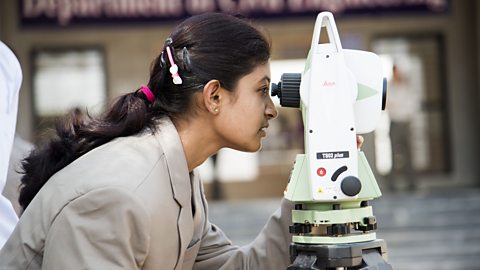There are two verbs for 'to be' in Spanish, ser and estar, and they are used in different ways.
The verb 'to be' in Spanish.
In Spanish, there are two verbs for ‘to be’: ser and estar and you use them for different things.
The verb ser goes like this:
soy - I am
eres - you are
es - he/she/it is
You can use it for describing people: soy alto (‘I’m tall’) or es deportiva (‘she is sporty’).
You can also use ser if you're talking about where you or someone else is from.
¿De dónde eres? - Where are you from?
Soy de España - I’m from Spain.
And to talk about what you do: Soy estudiante - I’m a student.
Mi padre es enfermero - My dad is a nurse.
Then there’s estar, the other Spanish verb for ‘to be’.
estoy - I am
±≤ı≥Ÿ√°≤ı - you are
±≤ı≥Ÿ√° - he/she/it is
You can use estar to talk about feelings:
How are you? - ¬øC√≥mo ±≤ı≥Ÿ√°≤ı?
Estoy feliz - I’m happy.
Or to talk about where people or things are located.
Estoy en Londres - I’m in London.
Excuse me, where is the cinema? - Perdona, ¬ød√≥nde ±≤ı≥Ÿ√° el cine?
You can also use it to talk about the condition something or someone is in:
My phone is broken - Mi m√≥vil ±≤ı≥Ÿ√° roto.
Those are the main differences between ser and estar so it’s great to know which one you need when!
To be: 'ser' in the present tense
The verb ser is used to indicate:
Nationality
- Soy inglés - I am English (masculine).
- Soy española - I am Spanish (feminine).
Where you are from
- ¿De dónde eres? - Where are you from?
- Soy de Inglaterra y soy inglesa - I am from England and I am English (feminine).
Professions
- Mi madre es médica - My mother is a doctor.
- Mi hermano es profesor - My brother is a teacher.
The date
- ¿Qué día es hoy? - What is the date?
- Hoy es el treinta y uno de julio - Today is the 31st July.
The time
- ¿Qué hora es? - What time is it?
- Son las once y media - It's half past eleven.
Characteristics of people or things
¿Cómo eres? - What do you look like?
Soy alta y llevo gafas - I am tall and I wear glasses.

The table below shows the different parts of ser for different people or things. Can you use them to give more information about yourself or someone or something you know?
| Spanish | English |
|---|---|
| soy | I am |
| eres | you are |
| es | he/she/it is |
'Ser' in the past tense
To talk about the past, the imperfect tense of the verb ser is very useful. It helps you describe what things were like or what they used to be like.
For example:
- La película era muy graciosa - The film was very funny.
- ¿Qué deportes hacías cuando eras más joven? - What sports did you do when you were younger?
- Cuando era m√°s joven, jugaba al tenis - When I was younger, I used to play tennis.
This table gives the verb ser in the past tense for different people and things. Can you use the different forms of the verb to give more information about yourself, or someone or something you know?
| Spanish | English |
|---|---|
| era | I was/used to be |
| eras | you were/used to be |
| era | he/she/it was/used to be |
'Ser' in the future tense
Use the immediate future tense to say what someone or something is going to be like.
For example:
- La semana que viene voy a visitar Londres. Va a ser muy divertido - Next week I am going to visit London. It is going to be very fun.
- El programa va a ser bastante aburrido - The programme is going to be quite boring.
- Voy a ser m√°s alto que mi padre - I am going to be taller than my father.
This table gives the verb ser in the future tense for different people and things.
Can you use the different forms of the verb to give more information about yourself, or someone or something you know?
| Spanish | English |
|---|---|
| voy a ser | I am going to be |
| vas a ser | you are going to be |
| va a ser | he/she/it is going to be |
To be: 'Estar' in the present tense
The verb estar is used to indicate:
Where something is located
- ¬ø∂Ÿ√≥≤‘ªÂ± ±≤ı≥Ÿ√° el libro? - Where is the book?
- El libro ±≤ı≥Ÿ√° en la mesa - The book is on the table.
Feelings and emotions and saying how you are
- ¬øC√≥mo ±≤ı≥Ÿ√°≤ı? - How are you?
- Estoy muy bien, gracias - I am very well, thank you.
The condition of someone or something
Mi hermana ±≤ı≥Ÿ√° enferma - My sister is ill.
El coche ±≤ı≥Ÿ√° roto - The car is broken.

This table gives the verb estar for different people and things. Can you use the different forms of the verb to give more information about yourself, or someone or something you know?
| Spanish | English |
|---|---|
| estoy | I am |
| ±≤ı≥Ÿ√°≤ı | you are |
| ±≤ı≥Ÿ√° | he/she/it is |
'Estar' in the past tense
Use the imperfect tense of estar to describe what, how or where someone or something was.
For example:
- Estaba en la calle - I was in the street.
- Mi madre estaba contenta - My mother was happy.
This table gives the verb estar in the past tense for different people. Can you use the different forms of the verb to give more information about yourself, or someone or something you know?
| Spanish | English |
|---|---|
| estaba | I was/used to be |
| estabas | you were/used to be |
| estaba | he/she/it was/used to be |
'Estar' in the future tense
Use the immediate future tense of estar to say what or how someone or something is going to or will be.
For example:
- ¬øVas a estar en casa m√°s tarde? - Are you going to be at home later?
- ¬ø∂Ÿ√≥≤‘ªÂ± vas a estar a las tres? - Where are you going to be at three o¬¥clock?
- Voy a estar en la cafetería - I am going to be in the café.
This table gives the verb estar in the future tense for different people. Can you use the different forms of the verb to give more information about yourself, or someone or something you know?
| Spanish | English |
|---|---|
| voy a estar | I am going to be |
| vas a estar | you are going to be |
| va a estar | he/she/it is going to be |
Find out how much you know about the verb 'to be' in Spanish with this activity!
Quiz
Find out how much you know about the verb 'to be' in Spanish with this short quiz!
Game - FestiLingo: Spanish. game
Visit the festival and practise Spanish language skills in this game

More on Grammar
Find out more by working through a topic